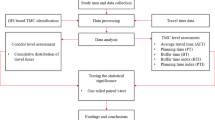Abstract
Tao Poon station is an interconnected station of the MRT Blue line and the MRT Purple line in Bangkok, Thailand. However, for the first 12 months of the MRT Purple line operations the interconnection to the Blue line was not possible due to a “missing link” issue. The Mass Rapid Transit Authority of Thailand (MRTA) provided a feeder system to facilitate the travel between the two lines. This paper presents the application of the simulation model using the PTV VISSIM/VISWALK software to study the impact of the two interconnected stations on passenger’s travel time. Modeling in this project includes three MRT stations: Bang Son station, Tao Poon station, and Bang Sue station. Then travel route choices are modeled for: a shuttle bus and a conventional train. By comparing the results generated by the software with the actual situation including the “blue line missing link,” the impact of the “missing link” on the passenger’s travel time was found. Overall, although the “missing link” distance was just 1.2 km, the impact of it on passenger’s travel time was huge. Normally, traveling in rush hour between Bang Sue and Tao Poon by MRT would take around 10 min, but traveling by a shuttle bus in the morning took up to four-times longer in the first 12 months of the MRT Purple line operations, before the “missing link” was finally fixed in August 2017.
Access this chapter
Tax calculation will be finalised at checkout
Purchases are for personal use only
Similar content being viewed by others
References
Mass Rapid Transit Authority of Thailand (2015) Developing pedestrian traffic simulation model of subway station: a case study of Sukhumvit Station of Mass Rapid Transit Authority
Phatipantakan P (2007) Mass transit system demand preference for Chiang Mai City. Department of Urban and Regional Planning, Chiang Mai University
Phumsiriphukdee V, Punjathana S (2015) Pedestrian simulation in mass transit station. Department of Industrial Engineering, Mahidol University
Weerawat W, Thongboonpian T (2018) Pedestrian transit simulation of feeder system case study of Tao Poon station, J Indus Tech 14(1), Jan-April 2018
Yaibok CH (2015) Improving traffic flow at four intersections on Karnjanavanich Road in Hat Yai, Prince of Songkla University
Acknowledgements
The authors would like to thank the Mass Rapid Transit Authority for their cooperation in collecting data used in this study.
Author information
Authors and Affiliations
Corresponding author
Editor information
Editors and Affiliations
Appendix
Appendix
Rights and permissions
Copyright information
© 2019 Springer International Publishing AG, part of Springer Nature
About this paper
Cite this paper
Weerawat, W., Thongboonpian, T., Fraszczyk, A. (2019). Impact of a “Missing Link” on Passenger’s Travel Time: A Case Study of Tao Poon Station. In: Fraszczyk, A., Marinov, M. (eds) Sustainable Rail Transport. Lecture Notes in Mobility. Springer, Cham. https://doi.org/10.1007/978-3-319-78544-8_4
Download citation
DOI: https://doi.org/10.1007/978-3-319-78544-8_4
Published:
Publisher Name: Springer, Cham
Print ISBN: 978-3-319-78543-1
Online ISBN: 978-3-319-78544-8
eBook Packages: EngineeringEngineering (R0)








